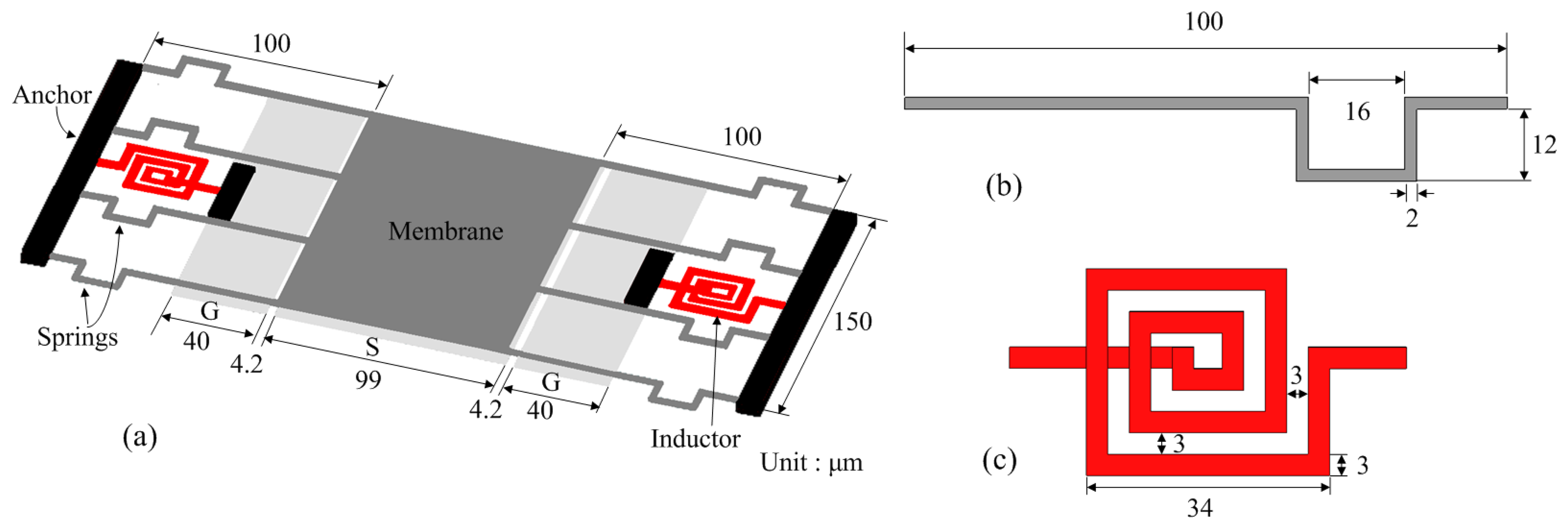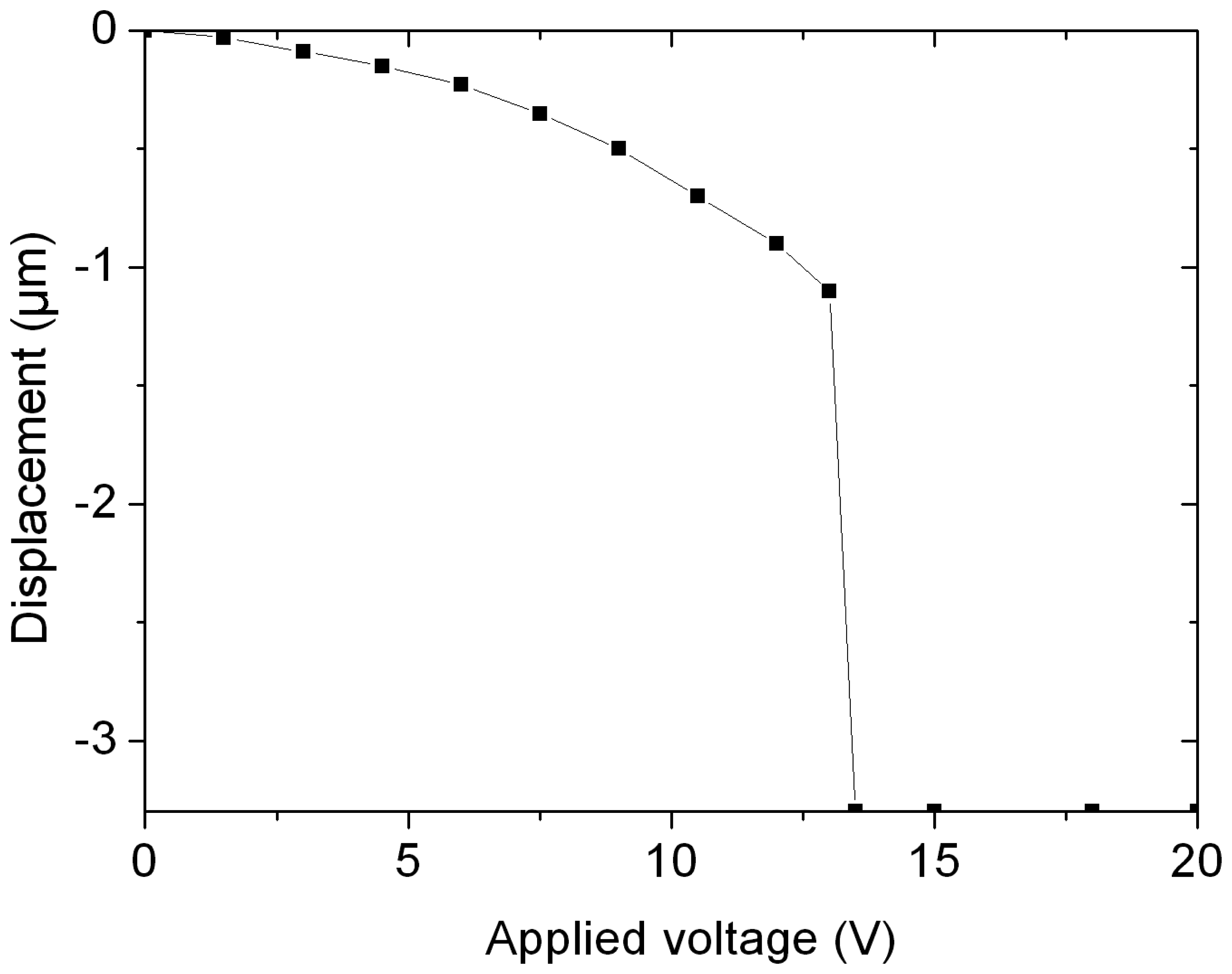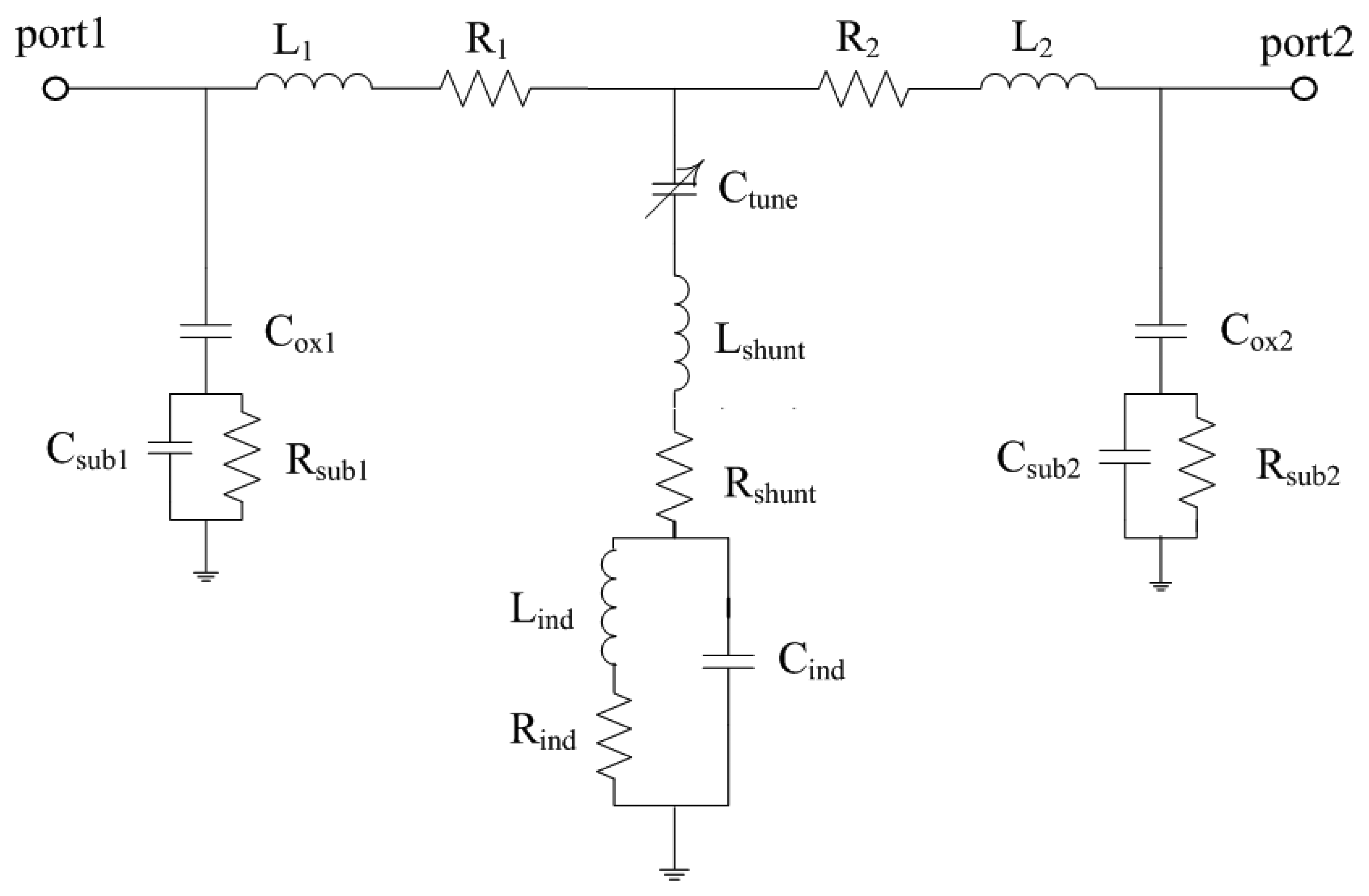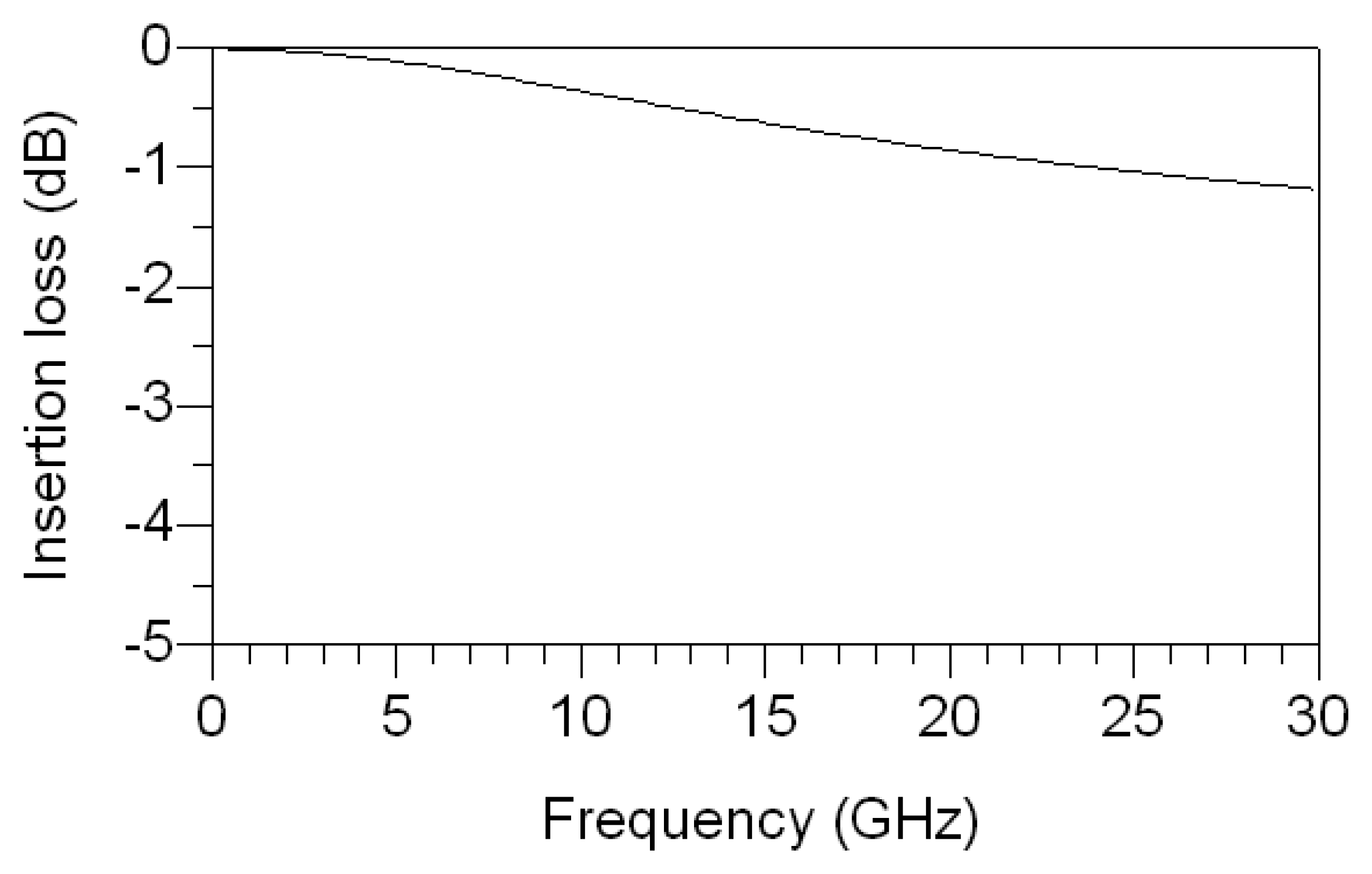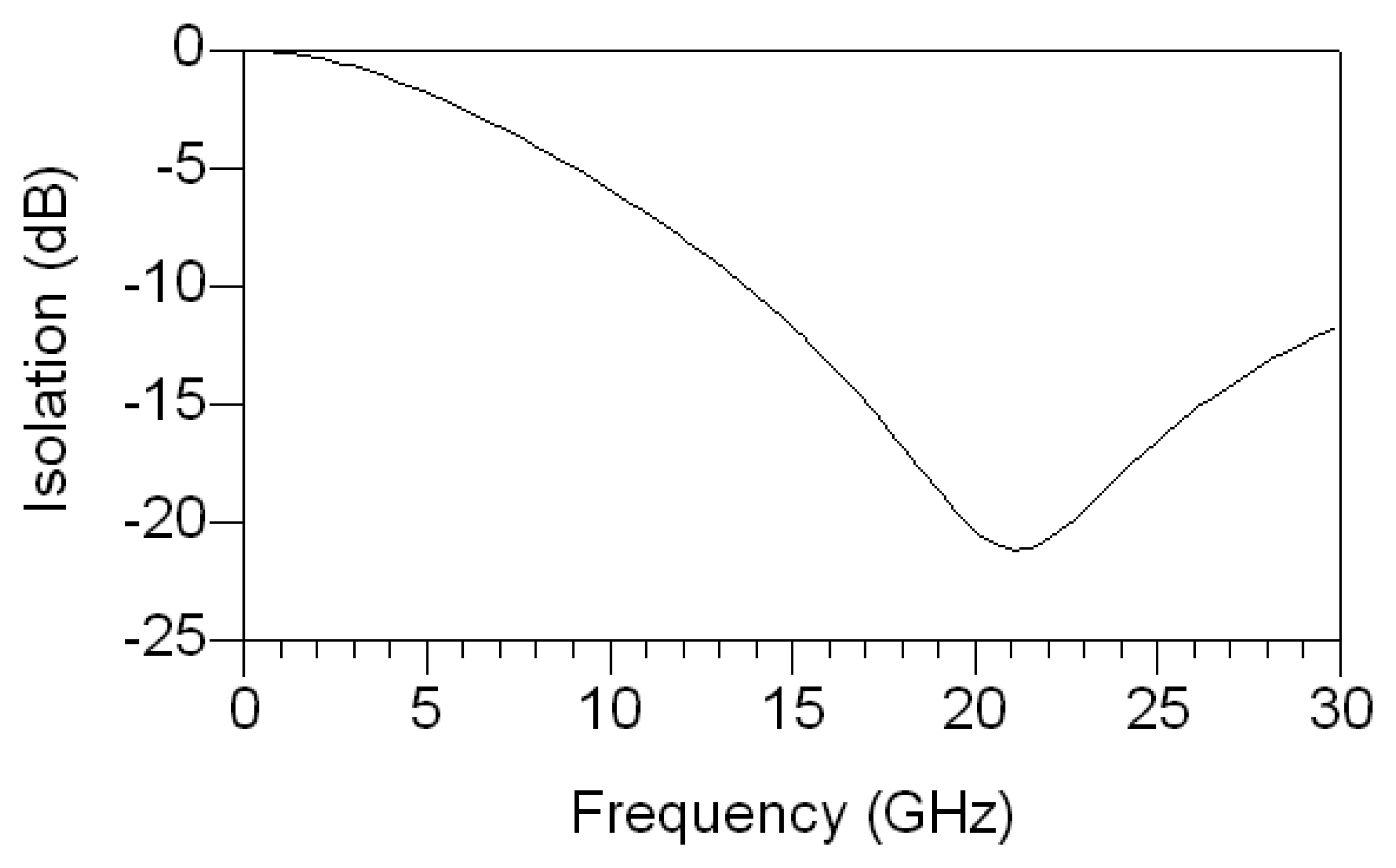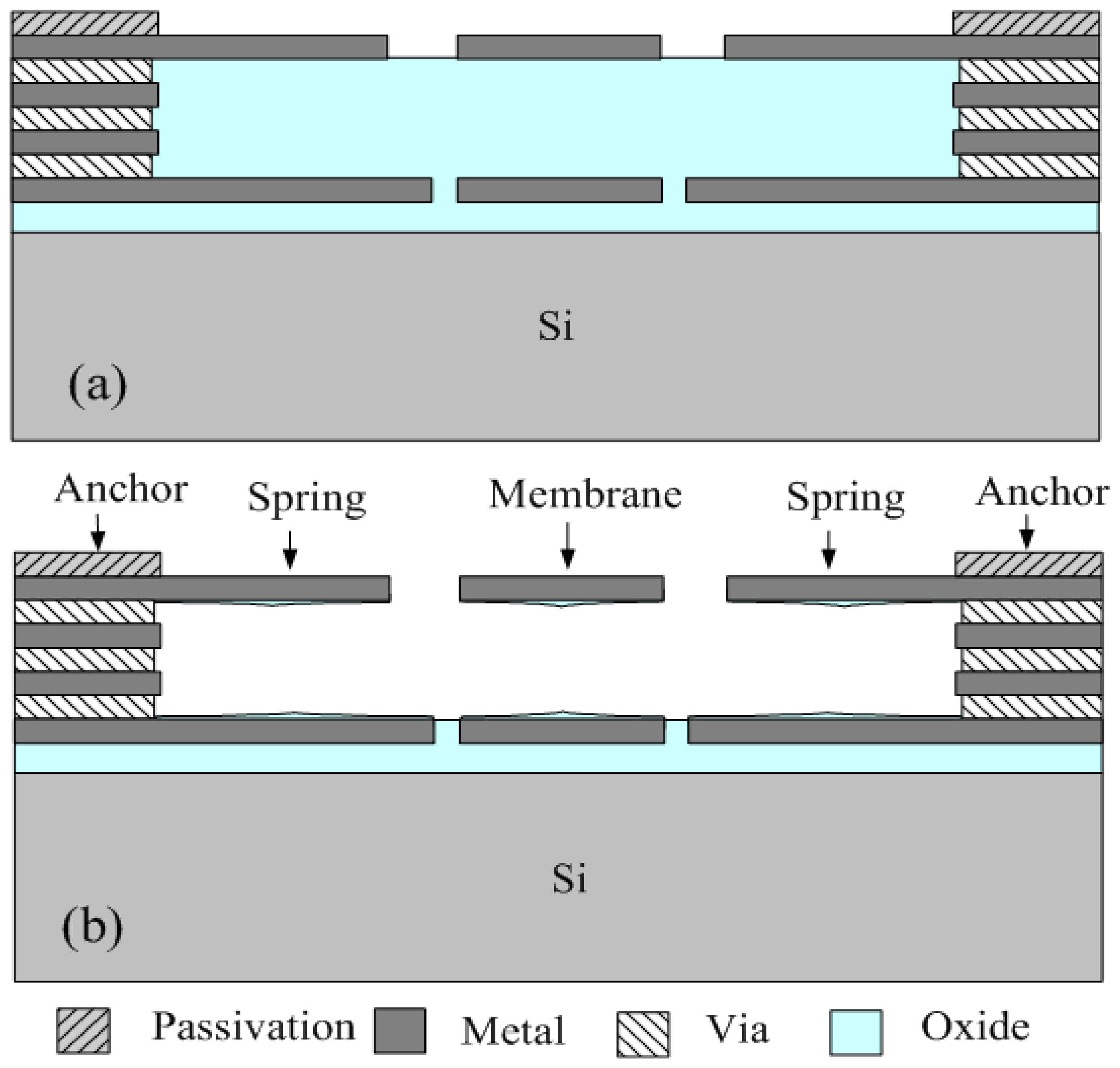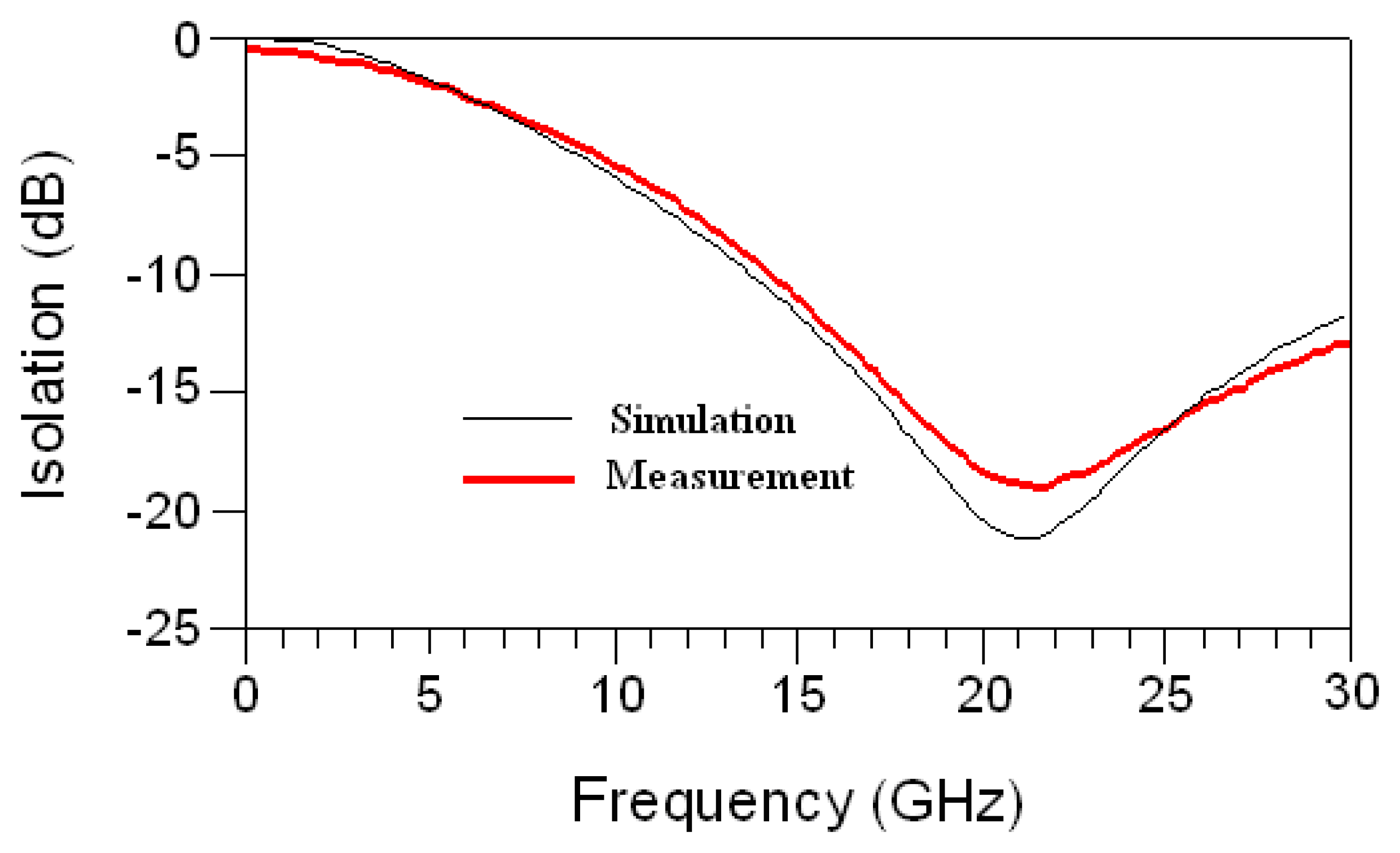Radio frequency (RF) switches are important components in wireless communication systems [
1]. A comparison with solid-state RF switches reveals that the micromechanical RF switches have the advantages of low insertion loss and excellent isolation, and high linearity at microwave and millimeter-wave frequencies [
2-
3]. Many micromechanical switches have recently been manufactured using microelectromechanical system (MEMS) technology. For instance, Zheng et al. [
4] employed a surface micromachining process to fabricate an RF MEMS membrane switch on GaAs substrate. The fabrication of the RF switch consisted of defining the CPW lines of AuGeNi/Au, depositing a dielectric layer of SiN and a sacrificial layer of polyimide, electroplating a membrane of Au and using developer to remove the sacrificial polyimide layer. The actuation voltage of the switch was about 17 V, and the switch had an insertion loss of 0.25 dB at 25.6 GHz and an isolation of 42 dB at 24.5 GHz. A micromachined microwave switch proposed by Chang et al. [
5] was made on a semi-insulating GaAs substrate using a surface micromachining process, in which the process included using lift-off technique to pattern the CPW lines of Cr/Au, depositing a dielectric layer of SiO2 and a sacrificial layer of amorphous silicon, defining the actuator structure layers of Al/Cr deposited by electron beam evaporation, and etching the sacrificial amorphous silicon layer to release the actuator structure. The switch had an actuation voltage of 26 V, and the insertion loss and isolation of the switch were 0.2 dB at 10 GHz and 17 dB at 10 GHz. Park et al. [
6] manufactured an RF MEMS capacitive switch using a surface micromachining process. The CPW lines of Cr/Au/Pt were formed by lift-off technique, and the dielectric of STO (strontium titanate oxide) was deposited by a RF sputter. Polyimide was adopted as a sacrificial layer, and the structure layer of Au was formed by electroplating technique. Finally, the movable structures were released by etching the sacrificial layer using a barrel plasma etcher. The switch had an isolation of 42 dB at 5 GHz and an insertion loss of 0.08 dB at 10 GHz, and the actuation voltage was 8 V. In this work, we employ the CMOS-MEMS technique to fabricate a micromechanical RF capacitive switch, which the fabrication of the switch is easier than Zheng et al. [
4], Chang et al. [
5] and Park et al. [
6]. The switch requires only one wet etching post-process to release the suspended structures after completion of the CMOS process. The post-process has the benefits of easy execution and low cost.
The technique that utilizes the commercial CMOS process to manufacture MEMS devices is known as CMOS-MEMS [
7-
8]. The advantage of micromechanical switches fabricated by the CMOS-MEMS technique is the capability for integration with RF circuits in the system-on-a-chip (SOC) application. We had used the CMOS-MEMS technique to develop a micromechanical switch [
9] on silicon substrate. In this work, series inductors are integrated with the micromechanical switch [
9] for improving its performance. The micromechanical RF switch with inductors is also fabricated using the CMOS-MEMS technique. A wet etching post-CMOS process is used to release the suspended structures of the switch. The switch that is actuated by an electrostatic force is a capacitive shunt type. Experimental results reveal that the actuation voltage of the switch is about 13 V, and the switch has an insertion loss of 1.7 dB at 21 GHz and an isolation of 19 dB at 21 GHz. Finally, in order to investigate the switch more deeply, an equivalent circuit is developed to evaluate the insertion loss and isolation of the switch.
2. Simulation of the RF switch
The structure of the micromechanical RF switch is illustrated in
Figure 1(a). The micromechanical RF switch consists of a membrane, eight springs, two inductors, anchors and CPW transmission lines. The CPW transmission lines are composed of ground (G), signal (S) and ground (G) lines. The signal line of CPW, which locates under the membrane, is 99 μm wide and about 0.67 μm thick. The ground lines of CPW are 40 μm wide and about 0.67 μm thick. The space between the ground and signal lines is 4.2 μm. The membrane and eight springs are the suspended structures, and the membrane is supported by eight springs. The area of the membrane is 99×150 μm
2. The anchors are connected to the ground lines of CPW by the inductors.
Figure 1(b) shows the dimensions of a spring that is 100 μm long and 2 μm wide, and all springs have the same dimensions. The thickness of springs and membrane is approximately 1 μm.
Figure 1(c) shows the dimensions of an inductor that has 2.5 turns, and the two inductors have the same dimensions. The RF switch, which is actuated by electrostatic force, is a capacitive shunt type. The membrane actuated by the electrostatic force stays in the down position upon applying an actuation voltage. The RF signal propagated in the signal line of CPW is coupled to the ground plane, so the switch is at the ‘off’ state. In contrast, the membrane supported by the springs stays in the up position when there is no applied voltage. The RF signal propagates in the signal line of CPW, so that the switch is at the ‘on’ state.
The finite element method software, CoventorWare, is utilized to simulate the behaviors of the micromechanical RF switch. The model of the micromechanical RF switch is established in accordance with the dimensions in
Figure 1, and then the model is meshed using triangular elements. The material of the switch is aluminum with a Young's modulus of 70 GPa, Poisson's ratio of 0.3 and mass density of 2679 kg/m
3[
10]. Finally, the displacement and stress of the switch are evaluated.
Figure 2 illustrates the displacement distribution of the switch with a driving voltage of 13 V, in which the membrane exhibits a uniform out-of-plane displacement of 3.3 μm.
Figure 3 depicts the relation between the membrane displacement and driving voltage in the switch. The simulated result shows that the switch has a pull-in voltage of about 13 V.
Figure 4 shows the stress distribution of the filter when a driving voltage of 13 V is applied. The maximum stress of 53 MPa located at the end of the springs in the switch is below the yield strength of aluminum (124 MPa). Therefore, the motion of the switch can be operated in the elastic range.
The Agilent CAD tool is used to calculate the characteristic impedance of the CPW. The dimensions of the CPW, as shown in
Figure 1(a), are inputted to the Agilent CAD tool, and then the calculation is executed.
Figure 5 demonstrates the calculated result of the CPW characteristic impedance. The calculated result shows that this CPW has a characteristic impedance of 50.2 Ω, and the value matches the impedance of 50 Ω in the network analyzer. This shows that the electromagnetic wave incident on this switch has a small return loss.
The equivalent circuit of the micromechanical RF switch is shown in
Figure 6. The series arm between port-1 and port-2 contains a resistor and an inductor, in which the two components are utilized to describe the signal line behavior. The parallel path at the middle position between ports is composed of C
tune, L
shunt, R
shunt, L
ind, C
ind and R
ind elements, where C
tune is the capacitance between the membrane and the signal line; L
shunt represents the inductance of the membrane and springs; R
shunt is the resistance of the membrane and springs; L
ind is the inductance of the series inductors; C
ind and R
ind are the capacitance and resistance of the series inductors, respectively. The three components of L
ind, C
ind and R
ind are adopted to describe the behavior of series inductors. The parallel path between ports to ground includes C
ox, C
sub, and R
sub elements. These components represent the silicon substrate loss in the switch. The component of C
ox represents the insulator capacitance under the signal line, and the elements of R
sub and C
sub are the resistance and capacitance of silicon substrate, respectively. Hence, the capacitance of C
tune is essential in this circuit, and the value of this capacitance expresses the ‘on’ and ‘off’ behaviors of the switch. According to the dimensions of the structure as shown in
Figure 1, the parameters of the switch are extracted using the Ansoft Q3D extractor.
Table 1 shows the extracted parameters of the switch. The Agilent ADS (advanced design system) is employed to simulate the characteristics of the equivalent circuit (
Figure 6) in accordance with the extracted parameters in
Tab. 1.
Figure 7 shows the simulated insertion loss of the switch in the ‘on’ state.
Figure 8 presents the simulated isolation of the switch in the ‘off’ state. The simulated results reveal that the micromechanical RF switch has an insertion loss of 0.9 dB at 21 GHz and an isolation of 21 dB at 21 GHz.
